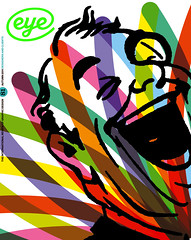Autumn 2011
Under Anger’s arcane spell
Kenneth Anger
By Alice L. Hutchinson; design by Hoop Associates<br>(second revised edition) Black Dog Publishing, £19.95Artistic innovation often originates at the margins among mavericks and outcasts. Kenneth Anger (b 1927) is one of the last of a generation of postwar filmmakers whose innovations pushed the medium away from theatrical narrative into areas more commonly associated with the visual immediacy of abstract painting.
The American director’s career spans 60 years, from early days as a teenage filmmaker to a dream-like promo film made last year for fashion house Missoni. If the career details are familiar they bear repeating: fêted by Tennessee Williams and Jean Cocteau for Fireworks (1947), his landmark fantasy of gay desire; a pioneer in the 1950s of what would later be called psychedelic cinema; the author of a pair of scurrilous books recounting Hollywood scandals; a dark star in hippy San Francisco and Swinging London, in whose orbit could be found the Rolling Stones, Marianne Faithfull, Donald Cammell, Jimmy Page and Manson Family member Bobby Beausoleil; above all else, the creator of the short films known collectively as The Magick Lantern Cycle, which have inspired Martin Scorsese and Derek Jarman, prefigured the work of David Lynch and had Michael Powell calling their director a genius.
Anger takes Lucifer, angel of light and heavenly disobedience, as his personal god, and true to Lucifer’s cry of ‘Non serviam!’ he has spent his life repudiating anyone who tries to label him. Contemporaries such as Stan Brakhage or Maya Deren had no qualms about being described as avant-garde or experimental; Anger preferred ‘independent’. His films could be formal but they were also rich and strange, influenced as much by Hollywood excess and occult symbolism as by Eisenstein’s montage. ‘Glamour’ was originally a word describing magical enchantment, and Anger is unique in twentieth-century cinema in making explicit the connections he sees between occult processes and the beguiling power of a medium he once described as a ‘black art’.
With such fertile material it is surprising we haven’t seen more studies of Anger’s work. Bill Landis covered the life in a gossipy biography, Anger (1995), in which he recounts the films’ production but does little more than describe the end result.
Alice L. Hutchison’s study reverses this, sketching enough biographical data to satisfy the uninitiated whilst exploring each film in detail. Separate chapters are devoted to each film in The Magick Lantern Cycle: Fireworks (1947), Puce Moment (1949), Rabbit’s Moon (1950), Eaux d’Artifice (1953), Inauguration of the Pleasure Dome (1954), Scorpio Rising (1963), Kustom Kar Kommandos (1965), Invocation of My Demon Brother (1969) and Lucifer Rising (1970-80), while gaps between completed works are filled so we learn more about the films that fell by the wayside, the planned adaptations of Lautréamont’s Les Chants de Maldoror and The Story of O, and a lost documentary about Aleister Crowley’s villa at Cefalù, Sicily.
From a design perspective, Anger’s juggling of arcane symbols and colour codes, and his persistence in treating performers as mythological figures, gives many of his images the vivid and indelible quality of Tarot designs. Hoop Associates has designed the book in landscape format, the better to accommodate the aspect ratio of the many carefully selected frame enlargements. This parade of frozen moments highlights Anger’s talent for finding striking and memorable images, from occultist Marjorie Cameron’s basilisk glare to the alluring glance of a shirtless biker. A wealth of supplementary documentation includes rare photographs, letters, poster designs and other ephemera.
Pioneers who live long enough can find their innovations being co-opted and diluted. Soundtracking footage with pop music is now so commonplace it is easy to forget this was once a fresh and surprising thing to do. Similarly, the once-controversial gay erotica of Fireworks is merely quaint when set beside the explicit couplings (and triplings) in John Cameron Mitchell’s Shortbus (2006). But Anger’s occult themes have particular relevance for a new generation of musicians and directors pursuing that combination of the esoteric, the hermetic and the nostalgic known as hauntology (as adopted by critic and author Simon Reynolds), and Hutchinson proves herself adept at explaining the philosophy without condescension whilst unpicking the layers of symbolism, allusion and cultural reference.
The Magick Lantern Cycle can now be seen on DVD but even Anger’s commentaries cannot cover every detail of the often hazardous production process: the evaporating finance, the errant collaborators, the lost (or stolen) reels, the multiple versions worked and reworked over decades. That the films have survived at all can seem like a miracle. Hutchinson’s book illuminates that miracle in an authoritative study that is an ideal companion for the films, as well as a lavish tribute to a man that Scorsese rightly called ‘an artist of exceptional talent’.
First published in Eye no. 81 vol. 21 2011
Eye is the world’s most beautiful and collectable graphic design journal, published quarterly for professional designers, students and anyone interested in critical, informed writing about graphic design and visual culture. It is available from all good design bookshops and online at the Eye shop, where you can buy subscriptions, back issues and single copies of the latest issue.

